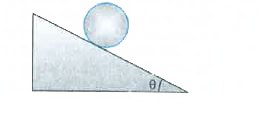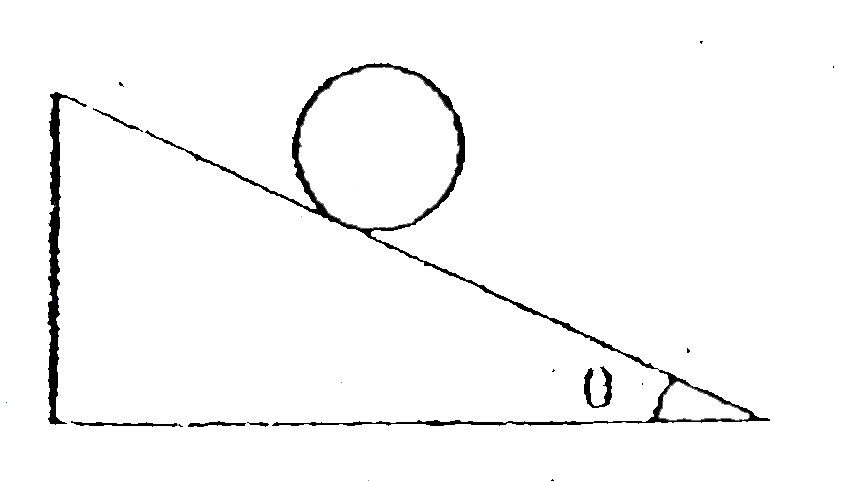A solid cylinder is rolling down the inclined plane without slipping. Which of the following is/are correct ?

The friction force is dissipative
The friction force is necessarily changing
The friction force will aid rotation but hinder translation
The friction force is reduced, if θ is reduced
The correct Answer is:C, D
Acceleration of centre of mass of cylinder is given by
acm=gsinθ1+IcmMR2=gsinθ1+MR2/2MR2=2gsinθ3
Since, Mgsinθ−f=Macm=M2gsinθ3
∴f=Mgsinθ3
Thus when θ is reduced, friction f will also decrease. Since point of application of frictional force is instantaneously at rest, the work done by friction will be zero, hence frictional force is not dissipative.

Further, as frictional force is static, its value can lie from 0 to μmgcosθ but not necessarily equal to μmgcosθ. Hence, the frictional force will provide torque for rotation but it will oppose translation.
Topper's Solved these Questions
- ROTATIONAL MOTIONBOOK - MODERN PUBLICATIONCHAPTER - ROTATIONAL MOTIONEXERCISE - LEVEL-III (MCQ)
10 Videos
- ROTATIONAL MOTIONBOOK - MODERN PUBLICATIONCHAPTER - ROTATIONAL MOTIONEXERCISE - RCQ
8 Videos
- ROTATIONAL MOTIONBOOK - MODERN PUBLICATIONCHAPTER - ROTATIONAL MOTIONEXERCISE - RCQ
8 Videos
- RAY OPTICSBOOK - MODERN PUBLICATIONCHAPTER - RAY OPTICSEXERCISE - RECENT COMPETITIVE QUESTION
32 Videos
- SOLIDS & SEMICONDUCTOR DEVICESBOOK - MODERN PUBLICATIONCHAPTER - SOLIDS & SEMICONDUCTOR DEVICESEXERCISE - Revision Test
28 Videos
Similar Questions
Knowledge Check
A solid cylinder is rolling down the inclined plane without slipping. Which of the following isare correct?
 AThe friction force is dissipativeBThe friction force is necessarily changingCThe friction force will aid rotation but hinder translationDThe friction force is reduced, if ~theta~ reduced
AThe friction force is dissipativeBThe friction force is necessarily changingCThe friction force will aid rotation but hinder translationDThe friction force is reduced, if ~theta~ reducedA solid cylinder is rolling down the inclined plane without slipping. Which of the following is correct?
 AThe friction force is dissipativeBThe friction force is necessarity changingCThe friction force will aid rotation but hinder translationDThe friction force is increased if θ is reduced
AThe friction force is dissipativeBThe friction force is necessarity changingCThe friction force will aid rotation but hinder translationDThe friction force is increased if θ is reducedIf a solid cylinder rolls down an inclined plane, then its:
Arotational energy is 1/3 and the translational energy 2/3 of its total K.E.Btranslational energy is 1/3 and rotational energy is 2/3 of its total K.E.Crotational and translational energies are equal.Dentire energy is rotational K.E.
A solid cylinder is rolling down a rough inclined plane of inclination θ. Then
View SolutionConsider a situation in which a ring, a solid cylinder and a solid sphere roll down on the same inclined plane without slipping. Assume that they start rolling from rest and having identical diameter.
The correct statement for this situation is:-
View SolutionA ring, a solid cylinder and sphere are rolled down on an inclined plane without slipping. Velocity of centre of mass is
View SolutionA solid cylinder is rolling down a rough inclined plane of inclination θ. Then
View SolutionA solid cylinder of mass M and radius R rolls down an inclined plane without slipping. THE speed of its centre of mass when it reaches the bottom is
View Solution
